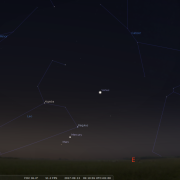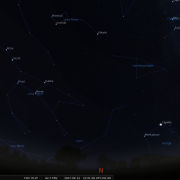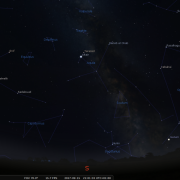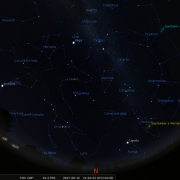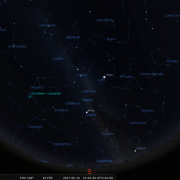In this month's Sky Notes:
Planetary Skylights
 Jupiter lingers in the evening twilight very low in the Northwest, but essentially from midmonth onwards it will become increasingly difficult to observe.
Jupiter lingers in the evening twilight very low in the Northwest, but essentially from midmonth onwards it will become increasingly difficult to observe.

 Saturn is also drawing closer to the west horizon, but is at least readily visible all month low to the Southwest. If you plan to observe Saturn using a telescope, do so as soon as it becomes dark enough to spot. Look for a conspicuous pearly white ‘star’ in that direction. A modest telescope will reveal the ring system, which is orientated favourably at present; but due to low altitude patience is required at the eyepiece, waiting for those tantalising steady seeing moments. Our Moon lies nearby on the 26th.
Saturn is also drawing closer to the west horizon, but is at least readily visible all month low to the Southwest. If you plan to observe Saturn using a telescope, do so as soon as it becomes dark enough to spot. Look for a conspicuous pearly white ‘star’ in that direction. A modest telescope will reveal the ring system, which is orientated favourably at present; but due to low altitude patience is required at the eyepiece, waiting for those tantalising steady seeing moments. Our Moon lies nearby on the 26th.
 Venus is visible in the pre-dawn sky located low in the ENE from around 03:00h. The brilliant ‘morning star’ should be unmistakeable. View on the 1st around 05:00h when Venus is in conjunction with M44 (the ‘Beehive’) in Cancer, lying just below the star cluster. Later in the month Venus slides toward Regulus – chief star of Leo, the crescent moon joining them on the 18th.
Venus is visible in the pre-dawn sky located low in the ENE from around 03:00h. The brilliant ‘morning star’ should be unmistakeable. View on the 1st around 05:00h when Venus is in conjunction with M44 (the ‘Beehive’) in Cancer, lying just below the star cluster. Later in the month Venus slides toward Regulus – chief star of Leo, the crescent moon joining them on the 18th.

 Both Mars and Mercury will also be visible in the dawn sky over in the east. Mercury actually has its best morning apparition of the year gaining nearly 10 degrees above the horizon by September 12th. Start viewing from the 5th around 05:30h. It will be joined by Mars as the red planet moves out of the glare of the sun and up into the dawn sky during September. On the 5th Mars lies upper left of Regulus, with Mercury off to the right, but by the 10th both planets lie below Regulus. All will be in the same 7 x 50 binocular field of view.
Both Mars and Mercury will also be visible in the dawn sky over in the east. Mercury actually has its best morning apparition of the year gaining nearly 10 degrees above the horizon by September 12th. Start viewing from the 5th around 05:30h. It will be joined by Mars as the red planet moves out of the glare of the sun and up into the dawn sky during September. On the 5th Mars lies upper left of Regulus, with Mercury off to the right, but by the 10th both planets lie below Regulus. All will be in the same 7 x 50 binocular field of view.
Mars and Mercury are closest on the 16th and 17th, the two planets crossing paths over those dates. Mercury will start the month quite faint, brightening as September rolls by, becoming conspicuous to the eye by the 20th . Mars will have an orange tinge, and appear slightly less bright than Regulus.
Meteors & Comets

There are no major noteworthy meteor showers in September; however you may spot a few Piscids which have two peaks: the 8th and the 21st. Rates are low, only 6 or 7 per hour at best. As with all meteor showers early morning viewing will be best.
September 2017 Sky Charts
|
Looking North
Mid-September - 21:00h |
Looking South |
|
Looking East
Mid-September - 21:00h |
Looking West
Mid-September - 21:00h |
| Northern Aspect Mid-September - 21:00h |
Southern Aspect Mid-September - 21:00h |
Additional Image Credits:
- Planets and Comets where not otherwise mentioned: NASA
- Sky Charts: Stellarium Software
- Log in to post comments


